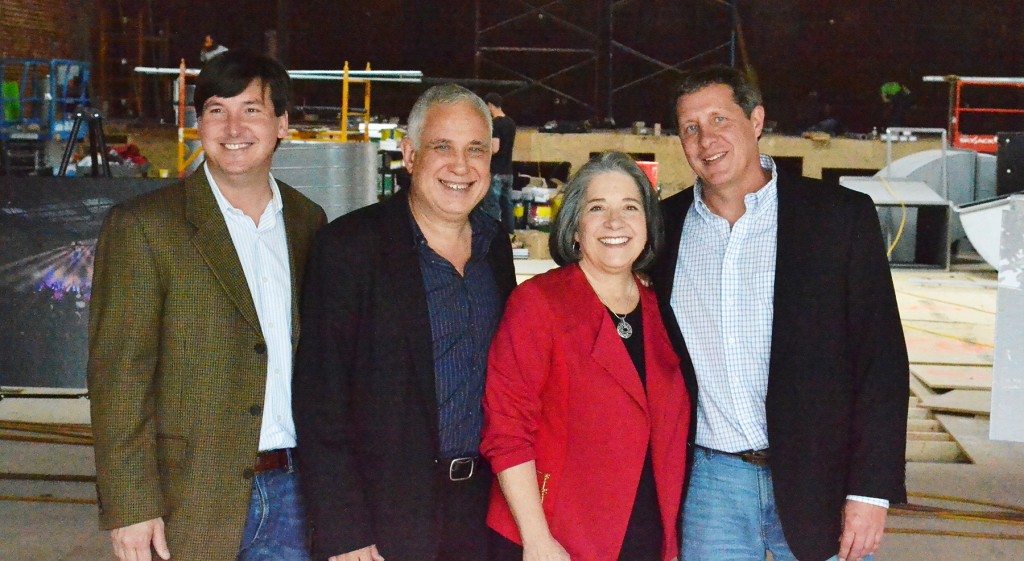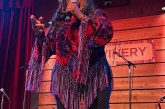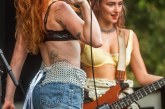
The Guide • Bela Fleck Interview • Ashley Capps Interview • BIG EARS: Appalachia • Music Norway • BIG EARS App (i) • BIG EARS App (Droid) • Tickets
Big Ears may be the most unlikely thing to ever become a Knoxville staple. A decade ago, who would have imagined that a festival of cutting edge music, modern classical, avant-garde, free jazz and just about everything else would call this city home?
“Oddly enough, it was a really natural thing for me,” says Ashley Capps, co-founder of the festival, over lunch at the Tomato Head.
Capps is the founder and head of AC Entertainment, which books the Tennessee and Bijou theaters, as well as many other venues throughout the Southeast. He and his company also co-founded Bonnaroo, and they book several other festivals across North America.
Capps began promoting shows in Knoxville in the late 1970s. He also had a radio show on University of Tennessee station WUOT-FM called “Unhinged,” which presented a wide variety of music that mirrored Capps’ personal tastes. Capps continued the show until 2004.
“I didn’t think about this for years, but someone pointed out to me that Big Ears is almost ‘Unhinged’ come to life,” says Capps. “Many of the same artists who are playing Big Ears this year are literally artists that you would hear on ‘Unhinged’ 20 or 30 years ago.”
The first Big Ears was held in 2009, and it took an organized effort to get it off the ground.
“It’s not totally my baby,” says Capps. “There are a lot of people who have contributed to the idea behind Big Ears and the execution of Big Ears from the very beginning, and they should get credit. In the early days, it was Jason Boardman and Chris Molinski, Steve Greene, who still works with me at AC Entertainment, and Laura Sohn, who was my assistant. Everybody contributed ideas from the very beginning.”
Part of what made Capps think the festival would work was seeing that music that was considered avant-garde in the ‘60s-‘80s was obviously influencing current music.
“The guys in Phish were huge Sun Ra fans,” says Capps. “In Radiohead, obviously Jonny Greenwood has an incredible depth and breadth of knowledge in classical music and especially contemporary classical music. You can hear the influence of Steve Reich loud and clear. DJ Shadow sampled Meredith Monk back in the mid-1990s. So the crossovers were always there. The people listening to the music didn’t always know what influences they were hearing, but they were there.”

at the opening of the Mill & Mine. BIG EARS housed the Venue’s first shows. •
photo by Rusty Odom
The first Big Ears included performances by Philip Glass, Antony and the Johnsons, Dan Deacon, Michael Gira, The Necks, Negativland and many other artists who rarely – if ever – ventured to non-major cities. The following year included minimalist legend Terry Riley, My Brightest Diamond, The National, Dirty Projectors and many others.
Accolades for Big Ears came from The New York Times, the New Yorker, Rolling Stone and music and culture publications from all over the United States and Europe.
The festival went on hiatus until 2014, when interest and funding from the Aslan Foundation, a Knoxville philanthropic organization, helped Capps revive it. It since has expanded the styles represented even further and has become one of the most anticipated music festivals in the world, drawing audiences to Knoxville from every continent except Antarctica.
Capps says that Big Ears is more like a food festival or a film festival in concept than it is a music festival.
“At a really good food festival, you got to see a bunch of different chefs who do different things. … There’s a diversity of food and different types of experiences people can have. A film festival is the same way. Film festivals will have documentaries, feature films, art films … famous artists and independent artists that no one has heard of, older established artists and young filmmakers. Music festivals tend to be genre-focused. A rock festival is mostly rock. A bluegrass festival is mostly bluegrass. A jazz festival is mostly jazz. A classical music festival is mostly classical music. So we break the mold a little bit in that regard.”
While festival organizers initially experimented with selling tickets to individual shows as well as to the full festival, Capps said it ended up limiting the audience. Instead, he says, it’s better to offer a ticket that is the price of a few major acts and let audiences also sample music they might not yet know they’d like. Talking with Big Ears attendees bears out that many buy in simply because they trust the music is going to be good even if they’ve never heard of most of the artists performing.
“People tell me often – and I love hearing it – that the most memorable things of the weekend are experiencing artists and going to things that they had no idea that they wanted to see,” says Capps. “I hope that the spirit of the festival helps to nurture that kind of openness. Just go for it. You can obviously make yourself miserable when you have too many choices. I do find that to be a little bit of a contradiction at times in the festival because most of the music we present really requires pretty immersive listening in order to be fully appreciated. And at the same time, there’s a million other things going on. But that’s kind of like life: You can either be diverted, or you can be focused. So, in a way, the discipline of paying attention to where you are [and] not worrying about where you’re not is a valuable skill set in life itself. What’s the book and the former music club in Asheville? Be Here Now. There’s a lot of wisdom in those three words.”
Capps says the festival has definitely changed the view some people have of Knoxville. While there was early skepticism of having the festival in the city, visitors fell in love with it. Many appreciated how many great venues it has, others liked the ease of getting around and some began to appreciate Knoxville’s history and indigenous culture.
That in part led to the Appalachia-centric theme of the 2018 festival.
“It’s certainly a big leap this year, but it’s been incubating for a long time,” says Capps. “For instance, Bela Fleck and Abigail Washburn in particular have been wanting to come to Big Ears, and we’ve been talking about them coming to Big Ears since it came back in 2014, at least. And there have been a couple of times that it almost happened and didn’t because of people’s schedules.”
The Knoxville Stomp, the 2016 festival that celebrated the Bear Family release of recordings made in Knoxville in 1929 and ’30, along with a few other factors gave Capps a nudge in this direction.
Big Ears veteran Sam Amidon participated in a panel and brought along old-time musicians Bruce Greene and Loy McWhirter. The two sang a cappella numbers that Capps says were inspirational. In 2017, Capps met Brooklyn-based fiddler and Appalachian-music enthusiast Anna Roberts-Gevault, whom he enlisted to really flesh out an Appalachian aspect for this year’s festival. One of the results will be a fiddle event on Market Square; a century ago, fiddlers’ conventions were a regular event at that same site.
“We’re not calling it a ‘fiddlers’ convention,’ but a ‘fiddlers’ happening,’” says Capps. “We gotta use some Big Ears language – going back to happenings that John Cage and Merce Cunningham and Robert Rauschenburg staged at Black Mountain College over in North Carolina. There are several dozen fiddlers from all over the region who are coming to participate in that. There’s also going to be a Big Ears square dance on Market Square and jam sessions late night at the Jig & Reel.”
And Capps points to dobro virtuoso Jerry Douglas, who will perform at Big Ears with his band (which includes three Knoxvillians), as being a sort of perfect Big Ears/Appalachia artist:
“Jerry is one of those artists who refuses to be pigeonholed. Everybody knows him from his work with Alison Krauss these days, which is certainly amazing, but I was just bamboozled by his new record. I was tuning in to Todd Steed’s radio program, and I was hearing this piece that was already on and I was thinking, ‘What is that? That sounds like an Irish jig … no, like Philip Glass … no, Miles Davis playing an Irish jig … and there’s some bluegrass. …’ That experience kind of embodies the Big Ears aesthetic.”
Capps says he hopes the festival both gives visitors an appreciation of Knoxville and helps give Knoxvillians a different view of themselves.
“It’s been an amazing thing to see unfold,” says Capps. “From where I sit, it’s very much a community event. It involves Andy Bliss and people from the University of Tennessee, the Knoxville Museum of Art, the Knoxville Symphony Orchestra, the Knoxville Jazz Orchestra, all of our wonderful downtown theaters, the Bijou and the Tennessee, but also our beautiful houses of worship, like St. John’s and Church Street. Visit Knoxville is involved. The city is involved. The county is involved. It really weaves together the culture of our city, and it’s an exciting foundation to build upon. … It’s exciting when people do embrace an event like Big Ears and embrace the city. Everyone who lives here, I hope, feels some pride and inspiration [about] the possibilities.
“I now have this chamber of commerce-like slogan: ‘Big Ears brings the world to Knoxville and showcases Knoxville for the world.’ That’s very chamber of commerce-y. Maybe they’ll send a check!”
The Guide • Bela Fleck Interview • Ashley Capps Interview • BIG EARS: Appalachia • Music Norway • BIG EARS App (i) • BIG EARS App (Droid) • Tickets







